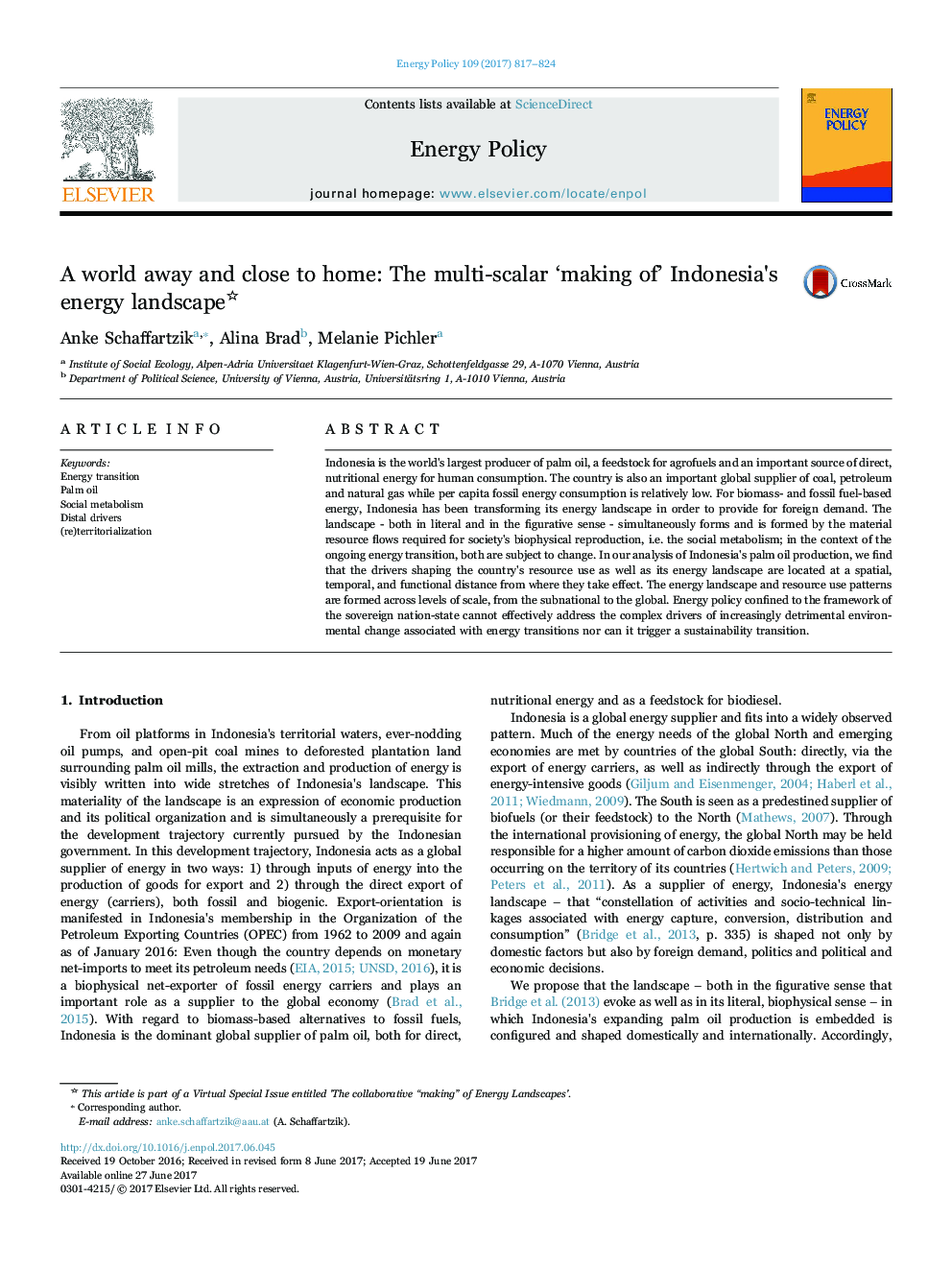| کد مقاله | کد نشریه | سال انتشار | مقاله انگلیسی | نسخه تمام متن |
|---|---|---|---|---|
| 5105733 | 1481249 | 2017 | 8 صفحه PDF | دانلود رایگان |
عنوان انگلیسی مقاله ISI
A world away and close to home: The multi-scalar 'making of' Indonesia's energy landscape
ترجمه فارسی عنوان
دنیای دور و نزدیک به خانه: ساخت چند منظر چشم انداز انرژی اندونزی
دانلود مقاله + سفارش ترجمه
دانلود مقاله ISI انگلیسی
رایگان برای ایرانیان
کلمات کلیدی
ترجمه چکیده
اندونزی بزرگترین تولید کننده روغن نخل در جهان است، یک منبع آلی برای سوخت های زیستی و منبع مهم انرژی مستقیم و مستقیم برای مصرف انسان است. این کشور همچنین یک تامین کننده جهانی مهم زغال سنگ، نفت و گاز طبیعی است در حالیکه مصرف انرژی فسیلی در سرانه نسبتا کم است. برای انرژی زیست توده و سوخت فسیلی، اندونزی چشم انداز انرژی خود را به منظور ارائه تقاضای خارجی تغییر داده است. چشم انداز - هر دو به معنای حقیقی و معنوی - به طور همزمان شکل می گیرد و بوسیله جریان های منابع مادی مورد نیاز برای بازتولید بیوفیزیکی جامعه، یعنی متابولیسم اجتماعی؛ در چارچوب انتقال انرژی جاری، هر دو موضوع تغییر می کنند. در تجزیه و تحلیل ما از تولید روغن نخل اندونزی، ما دریافتیم که رانندگان شکل دادن به استفاده از منابع کشور و همچنین چشم انداز انرژی خود را در فاصله زمانی، زمانی و کاربردی از جایی که آنها اثر می گذارد، قرار می گیرند. چشم انداز انرژی و الگوهای استفاده از منابع در سطوح مقیاس، از کشورهای محلی و جهانی تشکیل شده است. سیاست انرژی محدود به چارچوب دولت ملی مستقل نمی تواند به طور موثر به رانندگان پیچیده تغییرات زیست محیطی به طور فزاینده زیانبار مرتبط با انتقال انرژی اشاره کند و همچنین نمی تواند یک انتقال پایدار را ایجاد کند.
موضوعات مرتبط
مهندسی و علوم پایه
مهندسی انرژی
مهندسی انرژی و فناوری های برق
چکیده انگلیسی
Indonesia is the world's largest producer of palm oil, a feedstock for agrofuels and an important source of direct, nutritional energy for human consumption. The country is also an important global supplier of coal, petroleum and natural gas while per capita fossil energy consumption is relatively low. For biomass- and fossil fuel-based energy, Indonesia has been transforming its energy landscape in order to provide for foreign demand. The landscape - both in literal and in the figurative sense - simultaneously forms and is formed by the material resource flows required for society's biophysical reproduction, i.e. the social metabolism; in the context of the ongoing energy transition, both are subject to change. In our analysis of Indonesia's palm oil production, we find that the drivers shaping the country's resource use as well as its energy landscape are located at a spatial, temporal, and functional distance from where they take effect. The energy landscape and resource use patterns are formed across levels of scale, from the subnational to the global. Energy policy confined to the framework of the sovereign nation-state cannot effectively address the complex drivers of increasingly detrimental environmental change associated with energy transitions nor can it trigger a sustainability transition.
ناشر
Database: Elsevier - ScienceDirect (ساینس دایرکت)
Journal: Energy Policy - Volume 109, October 2017, Pages 817-824
Journal: Energy Policy - Volume 109, October 2017, Pages 817-824
نویسندگان
Anke Schaffartzik, Alina Brad, Melanie Pichler,
